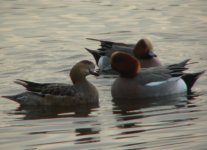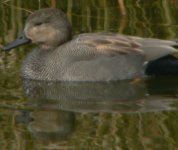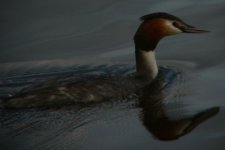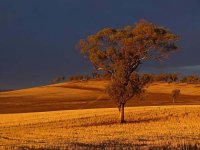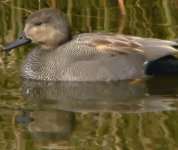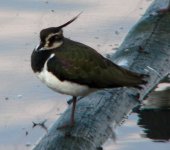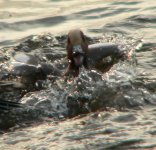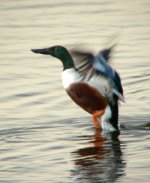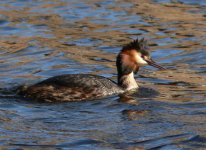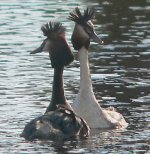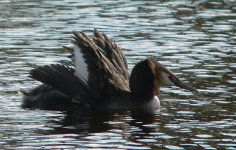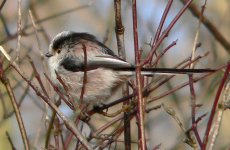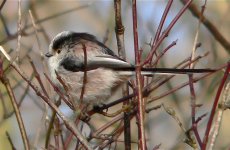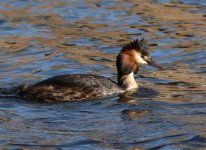lachlustre
Should be recording bird song
Less Frustrated with my Panasonic FZ20 (how do I get rid of the red face)
Hello,
I've had a Panasonic Lumix FZ20 for about 6 months. A couple of months ago, I added a Raynox 2.2 teleconverter, and bought myself a monopod to go along with it. Today was the first day I've been able to go out since with ideal conditions; until now I've been increasingly frustrated with the results: especially with, but even without the teleconverter. A word of warning: my only previous camera was a Canon Powershot G2, with which I took enough pictures I loved for me to invest more in this. Nevertheless, I have read up as much as I can on the tips and techniques, and have practiced, well if not assiduously, then regularly.
So... today I went out to my neighbourhood bird reservoir. I have figured that ducks must make ideal starting subjects since they sit around a lot and are quite large and close. I had a fantastic day's birding (peregrines, white-tailed eagle, goldeneyes and wigeons courting like crazy, my first black-necked grebe ao), and thought I'd also taken a bunch of decent photo's.
However, back on my computer, I notice that the things I am frustrated with are still around: my photo's are never as sharp as I expect, and I am suffering from horrendous purple fringes in many of my shots. I sometimes think someone could identify my tufted duck pictures as a new species, with a broad purple patch across its back...
Here are three photos to illustrate. One is a gadwall, which I have simply cropped to 800 pixels around the subject. The wigeons I have cropped about 1/3 of the frame, and resized to 800 pixels. The great-crested grebe I have cropped approx. half the frame, and resized. The camera set-up: I keep ISO on 80 now (noisy otherwise); I have spot-autofocusing & light-metering; and image-stabilizer on Mode 2 (these have all been recommended here, I think).
The exposure was 1/250 for the gadwalls, 1/200 for the two wigeon, 1/1000 for the grebe. That is probably a bit low for the first two, but even the third is still a bit soft, in my opinion.
I have deliberately not done any image manipulation (although especially the grebe is crying out for it), because I think the results coming out of my camera are simply not as good as they should be.
Have I reached the limits of my camera/teleconverter, or do any of you have any advice about how I could improve things?
Thanks,
Rob :hi: :hi: :hi:
Hello,
I've had a Panasonic Lumix FZ20 for about 6 months. A couple of months ago, I added a Raynox 2.2 teleconverter, and bought myself a monopod to go along with it. Today was the first day I've been able to go out since with ideal conditions; until now I've been increasingly frustrated with the results: especially with, but even without the teleconverter. A word of warning: my only previous camera was a Canon Powershot G2, with which I took enough pictures I loved for me to invest more in this. Nevertheless, I have read up as much as I can on the tips and techniques, and have practiced, well if not assiduously, then regularly.
So... today I went out to my neighbourhood bird reservoir. I have figured that ducks must make ideal starting subjects since they sit around a lot and are quite large and close. I had a fantastic day's birding (peregrines, white-tailed eagle, goldeneyes and wigeons courting like crazy, my first black-necked grebe ao), and thought I'd also taken a bunch of decent photo's.
However, back on my computer, I notice that the things I am frustrated with are still around: my photo's are never as sharp as I expect, and I am suffering from horrendous purple fringes in many of my shots. I sometimes think someone could identify my tufted duck pictures as a new species, with a broad purple patch across its back...
Here are three photos to illustrate. One is a gadwall, which I have simply cropped to 800 pixels around the subject. The wigeons I have cropped about 1/3 of the frame, and resized to 800 pixels. The great-crested grebe I have cropped approx. half the frame, and resized. The camera set-up: I keep ISO on 80 now (noisy otherwise); I have spot-autofocusing & light-metering; and image-stabilizer on Mode 2 (these have all been recommended here, I think).
The exposure was 1/250 for the gadwalls, 1/200 for the two wigeon, 1/1000 for the grebe. That is probably a bit low for the first two, but even the third is still a bit soft, in my opinion.
I have deliberately not done any image manipulation (although especially the grebe is crying out for it), because I think the results coming out of my camera are simply not as good as they should be.
Have I reached the limits of my camera/teleconverter, or do any of you have any advice about how I could improve things?
Thanks,
Rob :hi: :hi: :hi:
Attachments
Last edited:




